DAVAO CITY (MindaNews / 31 October) – At the waiting area outside the Southern Philippines Medical Center’s Adult Cancer Institute, a group of breast cancer patients gathers in a circle, around a row of seats transformed into a makeshift table laden with trays of spaghetti and empanada, praying for grace before meals and thanksgiving for this special celebration for Nanay Cha.
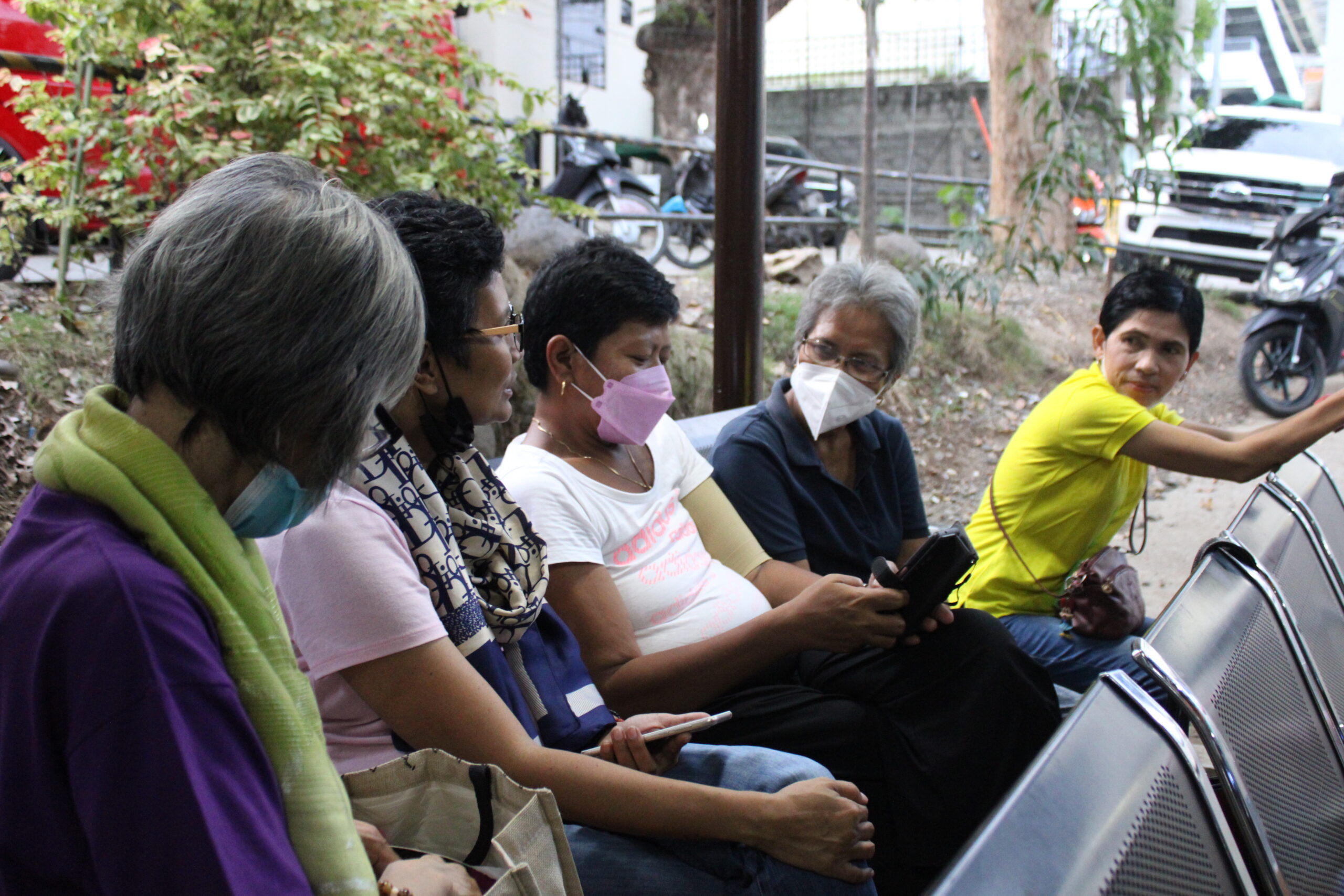 Breast cancer patients have formed lifelong friendships because of their shared ordeals. MindaNews photo by YAS D OCAMPO
Breast cancer patients have formed lifelong friendships because of their shared ordeals. MindaNews photo by YAS D OCAMPO
The 65-year old grandmother from Catalunan Pequeno is graduating from a month-long regimen of radiological treatment to kill what’s left of her breast cancer cells. She is surrounded by women battling the same cancer: her breast friends.
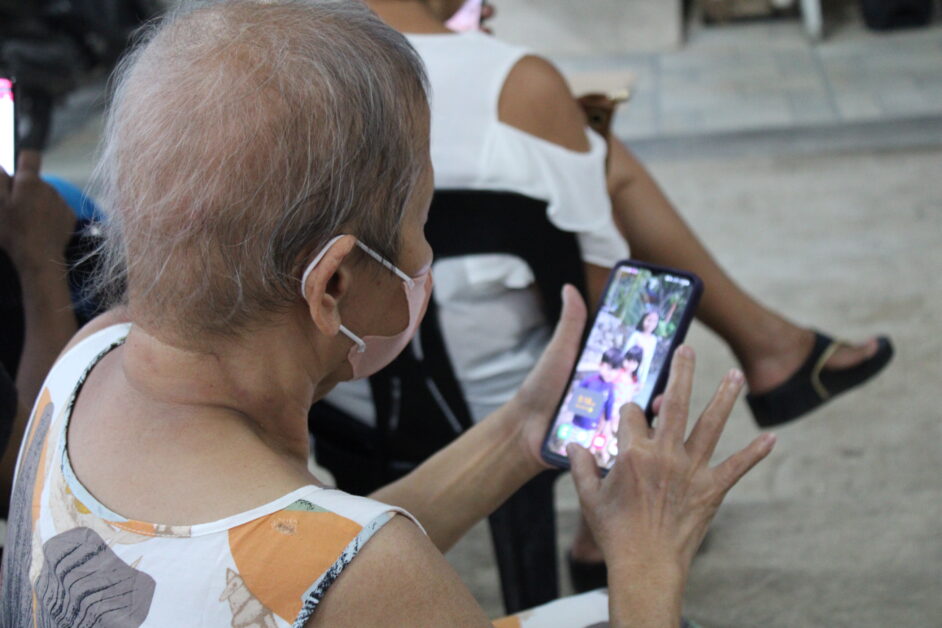 Breast cancer patient Nanay Cha is on her phone, her grandchildren her phone’s wallpaper, as she awaits her graduation party outside the Adult Cancer Institute at the SPMC. MindaNews photo by YAS D OCAMPO
Breast cancer patient Nanay Cha is on her phone, her grandchildren her phone’s wallpaper, as she awaits her graduation party outside the Adult Cancer Institute at the SPMC. MindaNews photo by YAS D OCAMPO
For weeks, patients like Nanay Cha have been relegated to a lonely regimen understood only by a select few, at the Adult Cancer Institute (ACI) which houses the lone radiology device shared by patients across all cancers. The therapy takes a few minutes only but as one would expect from a government hospital, patients have to wait for hours to avail of its services.
From out of this shared experience of waiting, emerged new friendships. Enter the Breast Friends messenger group chat (GC).
The GC started as a way for the patients to make sense of their progress outside the radiology facility. Membership constantly adds up as more patients are led towards the facility by their oncologists. This simple means of communicating with one another would forge friendship among former strangers.
Stereotypes
In popular media, cancers of any sort have been relegated to a stereotype: a frail, balding patient in a lab gown, usually at the brink of death, eyes lacking spark, and skin pale. In teleseryes and films, cancer patients are oftentimes portrayed as miserable and hopeless.
This portrayal has left a mark in the minds of patients like Hanie, 43, a teacher from Cotabato City. She felt an inexplicable loneliness after being diagnosed with a type of breast cancer.
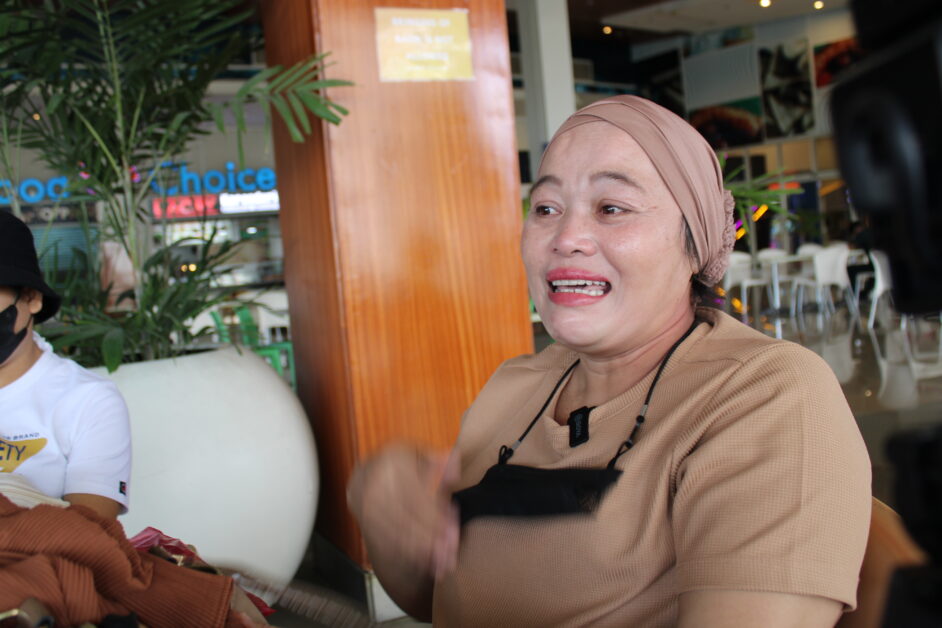 Hanie, a teacher from Cotabato, shares the hardships of feeling lonely amid a breast cancer diagnosis. MindaNews photo by YAS D OCAMPO
Hanie, a teacher from Cotabato, shares the hardships of feeling lonely amid a breast cancer diagnosis. MindaNews photo by YAS D OCAMPO
Hanie found a lump on her breast in October 2022 and decided to get herself checked. The lump was around 1.5 cm. It grew as she visited lab after lab and traveled to various cities in Mindanao. A doctor asked her to get an ultrasound and later, a biopsy.
With disbelief still overcoming her, she ignored the symptoms. But the lump grew. By February 2023, Hanie had herself checked at the Metro Davao Medical and Research Center in Davao City where she was told the lump had grown to 1.8 cm.
During those agonizing months, Hanie shifted between thinking of checkups, schedules, treatments, and a looming surgery. It didn’t help that she was afraid of swab tests.
Like most of the breast friends, Hanie was diagnosed towards the end of the global pandemic, when hospitals around the country still required swab tests, especially during major procedures. The cancer needed to be addressed immediately but she was afraid of swab tests. Eventually she had to let go of her fear as swabbing was a requirement before each chemotherapy session. “Mahirap magkasakit ng cancer,” (It’s difficult to have cancer), she said.
Hanie recalled she was initially in denial, as cancer was not in her family history. “There was no one to talk to. Whenever I think of what I went through, I’d end up in tears,” she said. While her family is supportive, Hanie longed for the company of people sharing her experience. Fighting the battle with zero peer support felt lonely until Hanie joined the GC.
The GC has allowed its members to cope with the stresses and ordeals of the breast cancer diagnosis, to take note which group of cancer is up on queue at the radiological device, or to alert every one of their places in the waiting line.
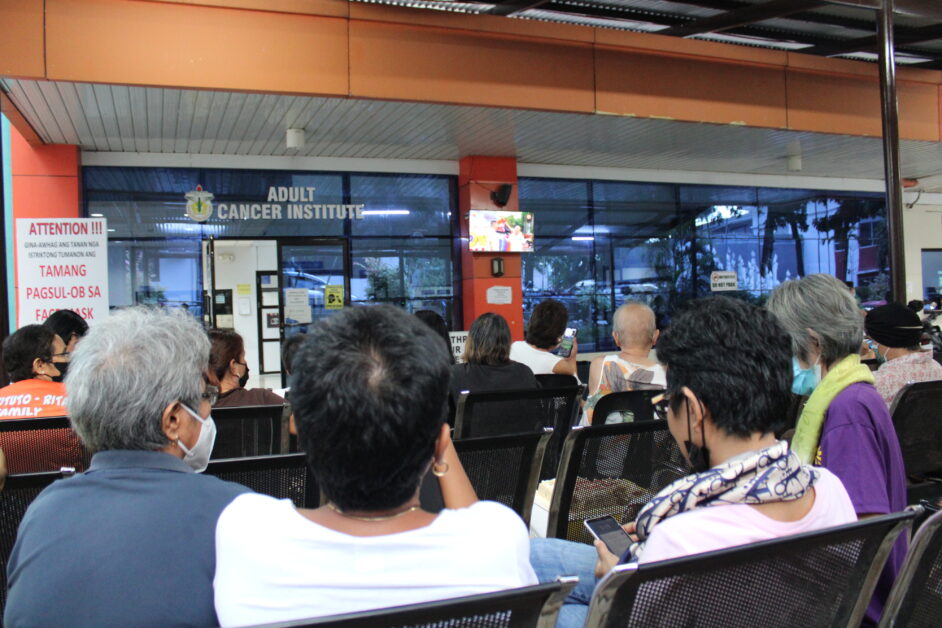 Breast cancer patients find new friends while waiting for their chemotherapy sessions at the Southern Philippines Medical Center’s Adult Cancer Institute radiology, and even beyond their “graduation.” MindaNews photo by YAS D OCAMPO
Breast cancer patients find new friends while waiting for their chemotherapy sessions at the Southern Philippines Medical Center’s Adult Cancer Institute radiology, and even beyond their “graduation.” MindaNews photo by YAS D OCAMPO
Throughout the everyday wait, the lonely ordeal was slowly no longer too solitary. “That’s what saddened me at first, that I would be alone,” Panacan resident Leeway said. The 47-year old businesswoman has battled breast cancer for more than a year, Stage 3, which is categorized as one of many kinds of cancers affecting around 189 out of 100,000 women, according to a study by the University of the Philippines Manila’s National Institutes of Health’s Institute of Human Genetics.
The numbers
The International Agency for Research on Cancer says breast cancer ranked 3rd among the types of cancers in the Philippines in terms of mortality in 2020. In that year, breast cancer ranked first among new recorded cases, at 27,163 out of 153,751. Breast cancer tops the list of prevalent cancers, with at least 156 out of 100,000 cases.
SPMC records show the number of patients diagnosed with breast cancer ranges from an average of 184 patients from 2019 to 2021, to 404 in 2022, Dr. Kenny Jun Demegillo, SPMC medical oncology section training officer, said. The rise is partly attributed to the easing of COVID-19 restrictions.
As COVID-19 protocols eased, more patients started flooding into SPMC to get themselves checked.
Friendships online and offline
Helping members keep their sanity is one of the benefits of having a breast friends GC.
A few weeks earlier, Leeway found out that, in spite of the months spent to battle the cancer cells and despite weeks of radiology, the site of her own mastectomy had started to leak. Her cancer cells had started spreading to the other breast. She was about to give up but her breast friends assured her she was not alone.
Marianne, a government employee, heard similar dreadful news. Her cancer had reached Stage 4. “I’d ask it to just stay there wherever it is, there’s no need to move around,” she joked. She is struggling through metastasis but her breast friends assist her every step of the way.
Lot, 59, suffers not only from the physical toll of the cancer and procedures, she also has her own mental health problems. When not working on her hospital requirements, Lot tends to her properties and has her life-partner around to assist.
Lot found out about her condition in the middle of the pandemic. “It really didn’t help that I usually get panic attacks when I feel distressed,” Lot said. And it didn’t help, too, that her relationship with her partner has become complicated.
Too close to home
Another patient, 60-year old Emma, is a mother of two. Her daughter works as a marketing manager in an IT firm in Metro Manila. Her son is the journalist writing this story.
Amid the pandemic, my mother found a lump on her breast in 2021 and informed us about her condition.
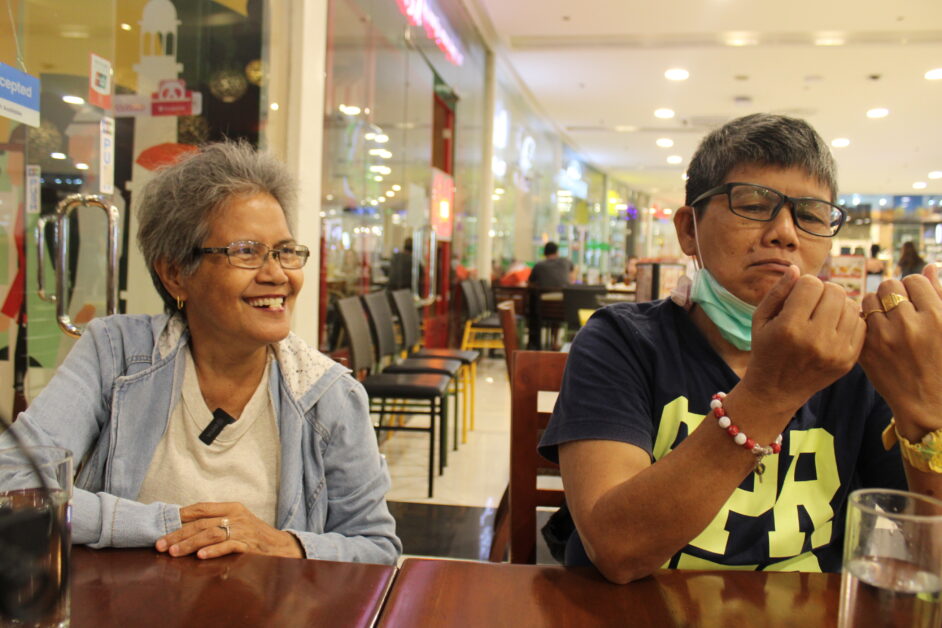 My mother and friend Lot swap stories about their breast cancer experience. MindaNews photo by YAS D OCAMPO
My mother and friend Lot swap stories about their breast cancer experience. MindaNews photo by YAS D OCAMPO
We didn’t push the issue at first. Financial considerations and the pandemic got in the way of a condition that could have been treated on time.
A day before her 59th birthday in 2022, my mother was diagnosed with ErPr Her2 NEU positive breast cancer, Stage 3.
The doctors had found lumps that had grown around her breast and her armpit. Blood tests and biopsies and other tests that were excruciating at times confirmed the results. I was around when the doctor confirmed the diagnosis. I beat myself up, mentally, as I am wont to do in crisis, and hide in my cocoon of multitasking.
The doctors estimated the total expenses to an amount our middle-class family had never seen before. At the back of my mind, I regretted giving up on jobs that could have funded the entire treatment.
“But the good news is, it’s very treatable,” the doctor assured.
My family has been through so much hardships in the past two decades that we had gotten used to adjusting to this one, to some extent. My sister, younger than me by eight years, is designated captain among us three. I help with the house upkeep and some of the legwork while my mother decides to fight the battle on her own terms. Having crossed mountains and rivers before, my mother is adamant on processing most of the documents herself.
Pismas the cat and lump finder
A life designed around the workplace soon shifted towards providing my mother immediate care. I moved away from my downtown rental to a place where I could be near helpful relatives and another onsite workspace where I provide consulting services in between teaching tasks. There were plants that needed tending and pets that had become my mother’s children in our absence, that needed feeding. The cats had to be looked after, and the dogs had to be walked.
My mother says it was one of her cats, Pismas, who first noticed the lump. The pandemic had separated mother, sister, and myself, so all my mother had were her cats and one of our aunts to help out at home. My mother said Pismas, as cats are wont to do, kneaded her breast one day and spotted the anomaly.
We decided to move into a larger rental house where I could manage the upkeep and give my mother the focus she needs. My sister, Stef, provides support from afar, and during the mastectomy in February 2023, she took care of stuff outside the hospital while I was the designated watcher. In three days, I found out what it feels like to memorize entire portions of a private hospital.
After the mastectomy, my mother’s oncologist prescribed a daily dose of radiation. At the SPMC, she would be bombarded for at least 30 days on weekdays to help remove what little remained of the cancer cells. Her therapy began in July but the overloaded radiotherapy machine conked out at least 12 days during the period so treatment spilled over to September.
Ask anyone among the breast cancer patients at the SPMC and they would always refer to my mother as the jolliest of the bunch, the most helpful, and most assertive. Hanie said she gave the clearest instructions about where to get help or how to line up for financial assistance. When scheduling at the ACI became chaotic, it was my mother who pushed to help reduce the waiting time by finding a shortcut that even management did not figure out. At the start of all treatment, the patients had to wait for hours to sign up, a few more hours to queue for the radiation schedule, and another few hours to wait for everything else. At the start of radiology, it was so chaotic that the staff at the hospital decided to draw lots so that waiting was “fair.”
But my mother, who used to leave home as early as 5 a.m. for a procedure that would start at around 10 p.m. and return home around 1 or 2 a.m., would have none of this anymore.
The seniors, she said, should go first. She asked the doctors if this could be done. And for a good while, all was well. What took at least 10 hours eventually trimmed into four.
The plan worked so well that the breast friends had to linger at the hospital some more if they were done by 8 p.m.
Everyone hated the rush hour traffic.
What it’s like
“I was ready to die when I found out,” my mother told me last month after I interviewed her breast friends.
“I asked myself, what else was I trying to achieve? My children are successful and happy, I’m not trying to prove anything. I am content,” she said. I held back tears at her answer, having seen her suffer through many other, harder things, Whatever the reason, one should never see a mother break down.
I recall that after her diagnosis. I treated her to pizza at the nearby mall to celebrate her birthday. “How do you feel?” she asked me. “I’m still processing what’s happening,” I told her, adopting the blank face I had learned to mask myself with in times of trouble. She confessed having cried secretly about what I said.
After a battery of tests that would test all her fears, my mother was a candidate for mastectomy and had to let go of her right breast. This was around the second quarter of 2022, still approaching the tail of a global pandemic. At this point, the family elected on continuing treatment at a private hospital, as restrictions and the volume of patients at the government hospital then would likely affect patient care.
Her mastectomy was scheduled for February 2023.
Nothing makes one feel so inadequate and helpless as during the waiting between surgeries and medical procedures.
When all the waiting is over, the doctor beckons me outside the operating room and shows me what was taken from my mother, the culprit up close.
The entire procedure takes three days, from intake to recovery. I do what I do best, and for most of her confinement, I take over my mother’s social media profile so she could rest. I set up to record her pre-op video message for friends and supporters following her progress; and when we get home, we record a thank you message for all her friends to see. For once in my life, I get to ground my mother.
Zooming out
In 2022, the National Demographic Health Survey, a national census conducted nationwide every five years, surveyed 27,821 women, aged 15 to 49, in different parts of the Philippines. According to the data, only one out of 10 had seen a medical professional or health worker to check if they were experiencing symptoms of breast cancer.
It is lowest in areas where Hanie lives, at only 2% in the Bangsamoro Autonomous Region in Muslim Mindanao and only 14% of women in places like the Davao region, as well as in Calabarzon and Central Visayas.
The survey was held from May 2 to June, the same period my mother was diagnosed for breast cancer.
The survey, however, did not include data on women 50 years and older, like my mother and Nanay Cha.
Survivorship journey
The SPMC has been making strides in encouraging treatment for breast cancer patients but Demegillo acknowledges there are pain points that the government hospital still needs to address.
SPMC, he said, has achieved a minimum timely diagnostic window for breast cancer patients. The numbers are based on the ideal period between phases of the patient’s survivorship journey.
Demegillo reported an average of 60 days from start of consultation to start of treatment for breast cancer patients. The end of neoadjuvant chemotherapy to surgery was also around 60 days. In 2022, due to the influx of patients, limited number of nurses and infusion facilities, the SPMC had to partner with other hospitals like the Davao Doctors Hospital to cater to patient surgery. This meant patients at the time had to wait around three months for a surgical schedule. What’s more, the hospital outpatient facilities cater to patients across all cancers only during weekdays.
The SPMC has since added more chairs at the adult infusion unit from donations and has set up dedicated breast surgery operating rooms.
The other realities patients have to endure, Demegillo said, are the limits of the PhilHealth’s Z Benefits Package of P100,000 for those with breast cancer. The package covers partial mastectomy or lumpectomy but does not cover radiotherapy costs.
Since the treatment cost goes beyond the P100,000 package, one has to look for other sources of funds. In places like Davao City, charitable organizations and politicians help fill in the gap.
Better than cure
The ideal percentage in terms of the number of patients who have decided to get checked up at the first sign of breast cancer is 60%, according to the World Health Organization.
“We are far from the 60%,” Demegillo admits.
Records at the SPMC’s ACI Outpatient Department show that only 36% of its patients are classified under Stage I or II.
To help improve awareness, the hospital held a caravan in February this year to incorporate social media language (TINGin TINGin TANGTANG BUKOL Caravan). The wordplay hops on the viral social media trend, a song titled Tang Ting Tang Ting by Titiek Sandhora. In Filipino, ‘tingin’ is to look, and in Cebuano, ‘tangtang’ is to remove. The wordplay works, tangtang, to remove cancer cells.
Chapters
By any means, the idea of Breast Friends as a reference for a group of peers going through breast cancer together isn’t exclusive or original. Run a Google Search and you’ll be led through various websites and Facebook Pages. For example, breastfriends.org is a Tigard, Oregon-based support group with a similar thrust.
In Davao City alone, there are at least three. The Breast Friends concept is also a project of the community outreach program of the Davao Doctors Hospital. My mother is also a member of this other support group.
According to my mother, the SPMC GC is called Breastfriends 2023, with a membership of at least 70 patients lining up for radiotherapy. There is another GC subset called Rad-1tuy, the name making fun of the patients’ loss of mass (1tuy is a joke among patients on losing one of two breasts; in Cebuano, tutoy means breast). This one is a much smaller GC. The DDH is made up of another demographic, a part of the private hospital’s community outreach programs, which runs the Hope Breast Friends GC. This has around 150 members. The San Pedro Hospital also has a similar cancer support group.
At the resort home of one of the members of the DDH-initiated support group, my mother joins another group of breast cancer patients who hold a thanksgiving by the sea. Everyone takes turns sharing how they feel, and all patients get a chance to be heard well into the night. The company is nurturing. The picturesque coastal road and the sea breeze from Punta Dumalag are a quiet backdrop to heavy conversations about silent suffering. Around 40 cancer survivors and patients gather, and the number rises as nightfall comes.
At the end of this session by the beach, the sea breeze blowing all night, the group all clad in a pink Breast Friends t-shirt, holds hands and sings “If We Hold on Together,” a classic song of friendship.
After singing, they say their goodbyes, and no one notices the length of time they have spent together. As thanksgivings go, the gathering is not without heavy food, which includes forbidden sweets and carbs. Usahay ra bitaw (It’s a rare occasion, anyway), they say.
Pain points
Throughout the SPMC’s cancer treatment services, Demegillo acknowledges the pain points that need to be addressed. He lists down a wishlist that could help improve the odds of patients going through the pains of breast cancer. The ACI could use a dedicated diagnostic unit for cancer patients, he said. This could include a centralized area for CT scans, bone scans, and MRIs.
Those who have gone through this process know how difficult and time-consuming it can be. And if you are a breast cancer patient going through chemo, the burden may leave one panting. In terms of personnel, the patients could use more manpower from the nursing service, he said.
A few times, the SPMC Breast Friends found themselves in a therapy gap of 12 days because the radiology machine conked out. Each of them, for example, was required by their doctors to go for 30-day radiology treatments. But my mother and Leeway made the best of the situation: they went on a road trip, their first in a long while, as the world opened up post-pandemic. It took a long time before the machine could be fixed. By then, they had gone on a trip that temporarily took their minds off the diagnosis.
Pain management
The patients outside the ACI have found various ways to make some of these pains go away. The breast friends swap stories, diets, and updates through the GC. My mother believes that the group has allowed her to make more lifelong friends.
Every graduation is a jolly occasion and always with a small, simple ceremony. The nurses and radiotherapists gamely join in, their smiles obvious even behind face masks. The graduating patient marches about in her hospital gown along the hallway of the radiotherapy center. The medical staff follow around, their phones playing everybody’s graduation song, the Triumphal March from Aida.
At the end of the march is the patient and their family taking photos with batchmates and fellow patients, the medical staff, too. The patients take turns passing around a pink sash, a pink graduation hat, and plastic flowers, for their graduation photo.
 Malls have included Breast Cancer Awareness among their marketing efforts, in partnership with civic organizations. Here, a Zumba group competes with other Davao-based dancers for a pink-themed Zumba contest at the SM City Davao Annex. MindaNews photo by YAS D OCAMPO
Malls have included Breast Cancer Awareness among their marketing efforts, in partnership with civic organizations. Here, a Zumba group competes with other Davao-based dancers for a pink-themed Zumba contest at the SM City Davao Annex. MindaNews photo by YAS D OCAMPO
Since the 1990s, pink has been the color used worldwide to represent the struggle of women battling breast cancer.
To date, the breast friends from SPMC have found excuses to come back to their waiting area. I have caught my mother several times, dressed up, ready to attend another classmate’s graduation day. The camaraderie has given her something to look forward to.
For most of these patients, it all boils down to having a support system of peers going through the same thing together.
Hanie agrees. “I’m the first in my family to have this condition,” she said. “If you talk to them about what I’m going through, they won’t understand.”
During her first chemotherapy sessions, Hanie’s family cried when they saw her suffer the side effects of nausea and overall weakness. Even with this sympathy, Hanie said she still longed for the company of patients going through the same ordeal.
The support of her family and breast friends, Hanie says, has made life more worth living.
“Sa tagal ko sa SPMC, naramdaman ko na hindi na ako nag-iisa (Having spent so much time at the SPMC, I feel I am no longer alone).” (Yas D. Ocampo / MindaNews)
The story is published with the support of the Philippine Press Institute, Philippine Cancer Society, ICanServe Foundation and Novartis in collaboration with the Swiss Chamber of Commerce of the Philippines and the Pharmaceutical & Healthcare Association of the Philippines.
